Paul Messier, Director of the Lens Media Lab at Yale University’s Institute for the Preservation of Cultural Heritage, announced that the lab will cease operations effective June 30, 2025.
A Legacy in Light: Yale’s Lens Media Lab to Close After a Decade of Discovery
NEW HAVEN, CT: Founded in 2015 with funding and vision from the John Pritzker Family Fund, the Lens Media Lab led a pioneering research program, integrating physics, data science, art history, and conservation science to study 20th century photographic materials. Through advanced analytical techniques, including large-scale measurement of physical and chemical properties, computer vision, and the creation of reference databases, the lab identified, classified, and contextualized thousands of photographic papers and prints. This interdisciplinary approach provided profound insights into expressive properties of paper, artistic practices, manufacturing histories, and preservation needs of photographic collections.

A selection of photographic papers from the Lens Media Lab’s collection.
Reflecting on the lab’s achievements, Messier stated, “When we began our work, the idea of applying empirical measurements to establish a ground truth for interpreting creative practice was untested and novel. Through deep interdisciplinary collaboration, we opened new doors for art history and conservation.”
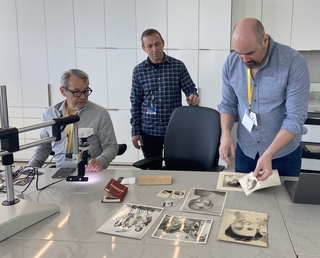
Paul Messier and Damon Crockett present Paperbase methodologies at a workshop held at the Getty Institute in February 2025.
The initial gift enabled Yale to acquire Messier’s reference collection of historic photographic papers—comprising over 7,500 examples identified by maker, brand, and date. Considered the largest of its kind globally, press accounts describe the collection as the “genome” of black-and-white photography. The lab also attracted funding from the Andrew W. Mellon Foundation and Google’s Artists + Machine Intelligence program. Institute director Alison Gilchrest noted, “Paul Messier’s Lens Media Lab surpassed every expectation set at its founding. Its ambitious multidisciplinary research, tools, and training programs leave an enduring legacy for scholarship in the history of analog photography.”
Research
Over its decade-long tenure, the Lens Media Lab collaborated with leading institutions including the Yale Center for British Art, the Yale University Art Gallery, the Library of Congress, the Center for Creative Photography at the University of Arizona, The Metropolitan Museum of Art, and the Guggenheim Museum. These partnerships utilized large-scale measurements of physical and visual properties to contextualize individual prints and analyze photographers’ material choices over time. Notable research revealed how renowned photographers—including Lola Álvarez Bravo, Bill Brandt, Robert Mapplethorpe, Tina Modotti, Man Ray, and Edward Weston— manifested their vision through materials.

Paperbase’s interface, featuring objects from the Lens Media Lab collection with data visualization.
In 2024, the lab launched Paperbase, an innovative online platform that integrates semantic descriptions with precise measurements of visual qualities—including reflectance, texture, and tone—to characterize the material properties of photographic papers from the 20th century. Built on over 95,000 data points and approximately 15,000 images from the LML reference collection, users praise Paperbase for its groundbreaking approach to data visualization.
Natalia Kiseleva of Nightingale: The Journal of the Data Visualization Society, described Paperbase as a “window into photographic paper history” that “suddenly …comes alive. A dataset that once seemed purely physical becomes interactive, shifting perspectives and taking on new forms. A powerful tool at the cutting edge of computational analysis.” Damon Crockett, LML Senior AI Engineer and principal author of Paperbase commented, “I think the lab ended up employing close to 20 people over the years. It was a unique career opportunity for all of us: many years to work without distraction, without worrying about getting the next grant. Perfect conditions for doing something new. And that’s what we did.”
Scholarly Contributions
The Lens Media Lab’s accomplishments were grounded in rigorous research methods evidenced through publications, symposia, and web-based applications. It authored more than twenty-five publications exploring topics such as the material properties and manufacturing histories of photographic papers, methods for authenticating and dating prints, and the influence of paper choice on the work of major 20th century photographers. Notable among these is the book Bill Brandt | Henry Moore (2020), co-edited by Martina Droth, Director of the Yale Center for British Art, and Paul Messier which was an Aperture Foundation finalist for best photography catalog of the year. More recently, in 2024, the lab contributed an invited article to The Art Bulletin titled “Closer Looking: Computer Vision in Material Studies of Art.”
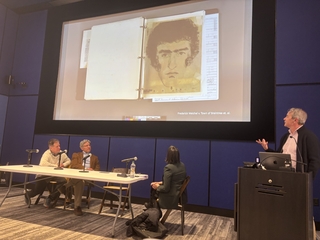
“36 Years: Fred Weichel’s exoneration at the intersection of art, law, and justice” panel discussion on March 5, 2025.
A legal contribution includes photographic evidence—analyzed and presented by Paul Messier—that played a pivotal role in the exoneration of Frederick Weichel, who was wrongfully incarcerated for murder in 1983. In early spring, the lab hosted a panel discussion at Yale that highlighted the powerful story of a physical photograph as interpreted through Messier’s expert testimony.
The lab also organized two major symposia at Yale. Material Immaterial: Photographs in the 21st Century (2019) and Darkroom to Data (2024) examined, respectively, the pivot from analog to digital photography and future research applications of the lab’s work.
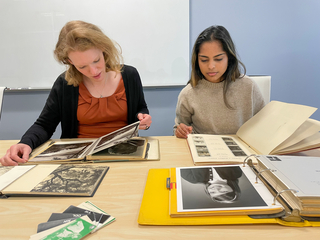
Sydney Nikolaus and Joitree Alam study photographic paper sample books.
An early and significant resource developed by the lab is TIPPS (Tipped-In Photographic Prints), an app focused on photographic prints in international photography journals and manuals published between 1855 and 1900. Developed through a collaboration with Library of Congress researcher Adrienne Lungren and LML art historian Kappy Mintie, scholars widely cite TIPPS for its data exposing regional and international trade patterns in 19th century photography. Other notable contributions include an online compendium of manufacturer markings applied to papers, and a site devoted to essays on the history of major manufacturers of photographic materials.
Teaching, Learning, and Community
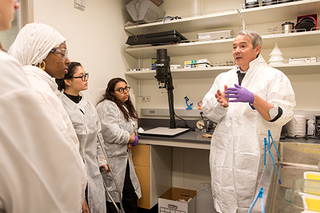
A cohort of students in The View From Here program visit the Lens Media Lab.
The scholarly work of the Lens Media Lab was deeply connected to engagement with Yale students, faculty, and the New Haven community. The lab hosted seven post-baccalaureate scholars who have gone on to pursue advanced degrees in robotics, art history, and library science. In collaboration with the Yale Center for British Art (YCBA), Paul Messier co-founded The View From Here, a program for New Haven region high school students, that teaches photographic history, materials, and practice using cell phone cameras—culminating in exhibitions on view at the YCBA, Yale West Campus, and Yale Schwarzman Center.
Paul Messier and Michelle Nearon, Senior Associate Dean for Graduate Student Development and Diversity, co-founded and co-directed the Cultural Heritage Research and Practice post-baccalaureate program—a two-year initiative for students preparing for PhD programs in the humanities. Messier also co-developed and co-taught an undergraduate course titled Material Histories of Photography, listed in both the Departments of History of Art and Ethnicity, Race & Migration. This course made extensive use of prints from across Yale’s collections.
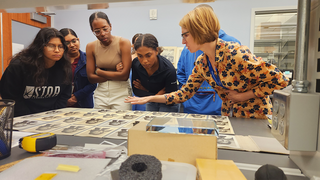
Kappy Mintie introduces students to objects in the reference collection.
Legacy
As operations wind down, Messier emphasized that while the Lens Media Lab is closing its doors, its contributions will continue to shape scholarship and cultural heritage preservation for years to come. The lab pioneered cross-institutional studies of print collections at Yale and with collaborators from across the United States and beyond. It created a unique interdisciplinary model that bridged sciences with the arts and humanities, utilizing data science, artificial intelligence, and traditional methods of art history.
In an era where darkroom practices are becoming increasingly remote, the work of the Lens Media Lab will remain an essential source of knowledge that influences the conservation, teaching, and study of photography, a critical medium for understanding society and culture. As paper-based photography declines, the lab’s foundational work in interpreting these materials will become even more crucial. By embracing a cross-disciplinary approach and fostering education and community engagement, the lab has not only helped preserve the tangible heritage of photography but also deepened academic and cultural appreciation for this vital medium.
# # #
About IPCH
The Institute for the Preservation of Cultural Heritage is Yale’s hub for science and culture. Its mission is to preserve and promote cultural heritage through interdisciplinary research, conservation, and educational opportunities. The Institute promotes collaborative partnerships across Yale’s collections and strengthens the cultural heritage field through international programs in the Global South and beyond. For more information, visit ipch.yale.edu.
Contact: Hannah Caputo, hannah.caputo@yale.edu
